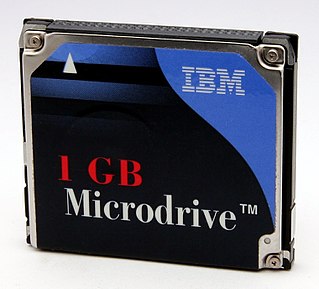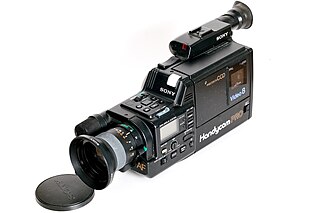Advantages
| | This section is empty. You can help by adding to it. (July 2010) |
CamCutter is a digital video camera technology developed by Ikegami and Avid Technology for recording broadcast quality video to hard disk, dubbed a Digital Disk Recorder. First revealed in 1995 at the National Association of Broadcasters convention in Las Vegas, it used a camera mechanism by Ikegami and a special FieldPack unit instead of a tape transport unit. The CamCutter outpaced subsequent tapeless camcorders introduced by Sony and Panasonic by years. In October 2010, the National Academy of Television Arts & Sciences (NATAS) announced the recipients of the 62nd Annual Technology & Engineering Emmy® Awards. Ikegami and Avid Technology were announced as a winner for the Development and Production of Portable Tapeless Acquisition. Today's CamCutter technology can be found in Ikegami's Editcam products.
Some of the features of being hard disk based was in-camera editing, faster than real time transfer of footage and the RetroLoop, which used a circular buffer to constantly record footage, and allowed saving a "take" after the action happened. This camera technology provides time lapse capture and animation modes (1 frame per trigger).
The price of the initial unit was between US$40,000 to $60,000. Ikegami and Avid developed a follow on tapeless acquisition camera, the DNS201 which shipped in the late 1990s. This unit sold for below US$30,000. In 2000, NL Technology spun out of Avid and continued developing two more generations of this technology. The DNS33 priced below US$30,000 and the hi definition Avid DNxHD camera, the HDN-X10, priced in between US$30,000 and $40,000.
| | This section is empty. You can help by adding to it. (July 2010) |
Due to its huge cost and prototype look and feel, many photographers did not use the initial hardware. Ikegami and NL Technology developed lower cost and more ergonomic versions that sold much better in the late 1990s and through 2010.

Non-linear editing is a form of offline editing for audio, video, and image editing. In offline editing, the original content is not modified in the course of editing. In non-linear editing, edits are specified and modified by specialized software. A pointer-based playlist, effectively an edit decision list (EDL), for video and audio, or a directed acyclic graph for still images, is used to keep track of edits. Each time the edited audio, video, or image is rendered, played back, or accessed, it is reconstructed from the original source and the specified editing steps. Although this process is more computationally intensive than directly modifying the original content, changing the edits themselves can be almost instantaneous, and it prevents further generation loss as the audio, video, or image is edited.

Video on demand (VOD) is a media distribution system that allows users to access videos without a traditional video playback device and the constraints of a typical static broadcasting schedule. In the 20th century, broadcasting in the form of over-the-air programming was the most common form of media distribution. As Internet and IPTV technologies continued to develop in the 1990s, consumers began to gravitate towards non-traditional modes of content consumption, which culminated in the arrival of VOD on televisions and personal computers.

Videotape is magnetic tape used for storing video and usually sound in addition. Information stored can be in the form of either an analog or digital signal. Videotape is used in both video tape recorders (VTRs) and, more commonly, videocassette recorders (VCRs) and camcorders. Videotapes have also been used for storing scientific or medical data, such as the data produced by an electrocardiogram.
A hard disk recorder (HDR) is a system that uses a high-capacity hard disk to record digital audio or digital video. Hard disk recording systems represent an alternative to reel-to-reel audio tape recording and video tape recorders, and provide non-linear editing capabilities unavailable using tape recorders. Audio HDR systems, which can be standalone or computer-based, are typically combined with provisions for digital mixing and processing of the audio signal to produce a digital audio workstation (DAW).

A camcorder is a self-contained portable electronic device with video and recording as its primary function. It is typically equipped with an articulating screen mounted on the left side, a belt to facilitate holding on the right side, hot-swappable battery facing towards the user, hot-swappable recording media, and an internally contained quiet optical zoom lens.

A professional video camera is a high-end device for creating electronic moving images. Originally developed for use in television studios or with outside broadcast trucks, they are now also used for music videos, direct-to-video movies, corporate and educational videos, wedding videos, among other uses. Since the 2000s, most professional video cameras are digital professional video cameras.

Iomega produced external, portable, and networked data storage products. Established in the 1980s in Roy, Utah, United States, Iomega sold more than 410 million digital storage drives and disks, including the Zip drive floppy disk system. Formerly a public company, it was acquired by EMC Corporation in 2008, and then by Lenovo, which rebranded the product line as LenovoEMC, until discontinuation in 2018.

HDV is a format for recording of high-definition video on DV cassette tape. The format was originally developed by JVC and supported by Sony, Canon, and Sharp. The four companies formed the HDV Consortium in September 2003.
A helmet camera, otherwise known as a micro video camera, is an action camera, usually a closed circuit television camera, attached to a helmet allowing someone to make a visual record from their point of view (POV), while keeping their hands and vision free.
Editcam is a professional digital camera system manufactured by Ikegami and first introduced in 1995, available both as professional camcorders and modular dock recorders. It is the first ever tapeless field acquisition device and has evolved into a range of SD and HD cameras. As a portable camera system, it can record digital video data direct to a hard disk drive (HDD).
Ikegami Tsushinki Co., Ltd. is a Japanese manufacturer of professional and broadcast television equipment, especially professional video cameras, both for electronic news gathering and studio use. The company was founded in 1946.

The Microdrive is a registered trademark for miniature, 1-inch hard disks produced by IBM and Hitachi. These rotational media storage devices were designed to fit in CompactFlash (CF) Type II slots. The release of similar drives by other makers led to them often being referred to as "microdrives" too. By 2010, Microdrives were viewed as obsolete, having been overtaken by solid-state flash media in read/write performance, storage capacity, durability, and price.

Digital cinematography is the process of capturing (recording) a motion picture using digital image sensors rather than through film stock. As digital technology has improved in recent years, this practice has become dominant. Since the mid-2010s, most movies across the world are captured as well as distributed digitally.
Offline editing is part of the post-production process of film making and television production in which raw footage is copied and the copy only is then edited, thereby not affecting the camera original film stock or video tape. Once the project has been completely offline edited, the original media will be assembled in the online editing stage.
The Technology and Engineering Emmy Awards, or Technology and Engineering Emmys, are one of two sets of Emmy Awards that are presented for outstanding achievement in engineering development in the television industry. The Technology and Engineering Emmy Awards are presented by the National Academy of Television Arts and Sciences (NATAS), while the separate Primetime Engineering Emmy Awards are given by its sister organization the Academy of Television Arts & Sciences (ATAS).

Sony Corporation produces professional, consumer, and prosumer camcorders such as studio and broadcast, digital cinema cameras, camcorders, pan-tilt-zoom and remote cameras.
Broadcast Television Systems (BTS) was a joint venture between Robert Bosch GmbH's Fernseh Division and Philips Broadcast in Breda, Netherlands, formed in 1986.

SanDisk Professional is a brand of Western Digital that produces external storage products designed and marketed for the Macintosh, creative pro, photography and A/V markets. Its USB, FireWire, eSATA, SAS, SCSI Thunderbolt, and Fibre Channel systems support all levels of audio/video production.

ABS-CBN HD was a Philippine pay television channel, working as the high-definition feed of ABS-CBN. It was launched on October 3, 2015 initially on Sky Cable and Destiny Cable and later on iWant, Sky On Demand, and Sky Direct, broadcasting in 1080i at a frame rate of 50 fps or at 60fps. Until May 5, 2020, all Sky Cable and Sky Direct plans in Metro Manila offer ABS-CBN HD. The network including its HD feed went off-the-air on May 5, 2020 at 7:52pm following TV Patrol. It was replaced by Kapamilya Channel HD on June 13, 2020.